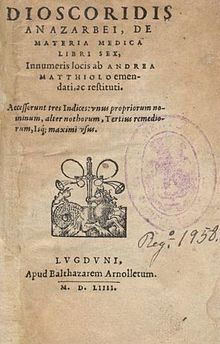 Cover of an early printed version, Lyon, 1554 | |
| Author | Pedanius Dioscorides |
|---|---|
| Original title | Περὶ ὕλης ἰατρικῆς |
| Language | Greek |
| Subject | Medicinal plants, drugs |
| Genre | Non-fiction |
Publication date | 50–70 |
| Publication place | Ancient Rome |
Published in English | 1655 (first English translation) |
| Media type | Manuscript, print |
| Pages | 5 volumes |
| Text | De materia medica at Wikisource |
De materia medica (Latin name for the Greek work Περὶ ὕλης ἰατρικῆς, Peri hulēs iatrikēs, both meaning "On Medical Material") is a pharmacopoeia of medicinal plants and the medicines that can be obtained from them. The five-volume work was written between 50 and 70 CE by Pedanius Dioscorides, a Greek physician in the Roman army. It was widely read for more than 1,500 years until supplanted by revised herbals in the Renaissance, making it one of the longest-lasting of all natural history and pharmacology books.
The work describes many drugs known to be effective, including aconite, aloes, colocynth, colchicum, henbane, opium and squill. In total, about 600 plants are covered, along with some animals and mineral substances, and around 1000 medicines made from them.
De materia medica was circulated as illustrated manuscripts, copied by hand, in Greek, Latin, and Arabic throughout the medieval period. From the 16th century onwards, Dioscorides' text was translated into Italian, German, Spanish, French, and into English in 1655. It served as the foundation for herbals in these languages by figures such as Leonhart Fuchs, Valerius Cordus, Lobelius, Rembert Dodoens, Carolus Clusius, John Gerard, and William Turner. Over time, these herbals incorporated increasing numbers of direct observations, gradually supplementing and eventually supplanting the classical text.
Several manuscripts and early printed versions of De materia medica survive, including the illustrated Vienna Dioscurides manuscript written in the original Greek in 6th-century Constantinople; it was used there by the Byzantines as a hospital text for just over a thousand years. Sir Arthur Hill saw a monk on Mount Athos still using a copy of Dioscorides to identify plants in 1934.